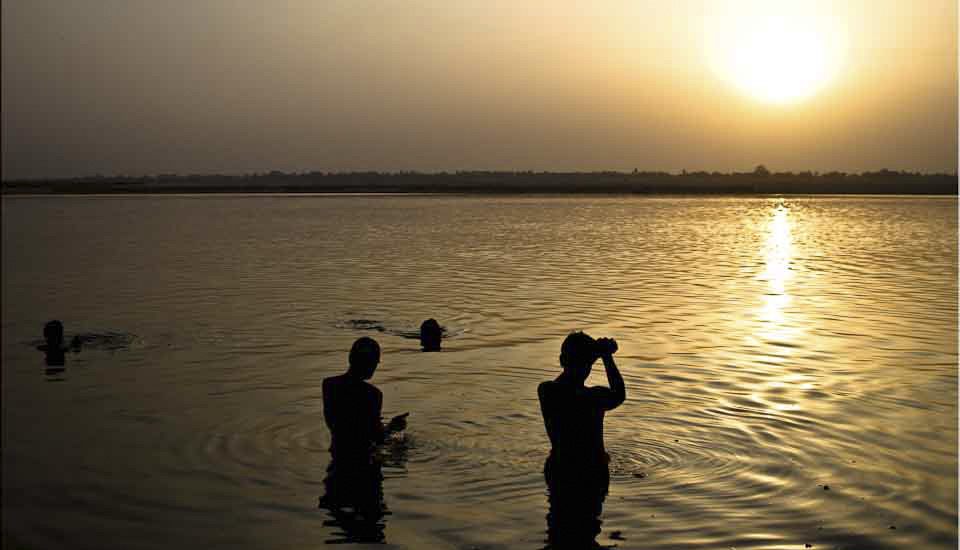.jpg)
Melk Abbey from Below
The charming Austrian town of Melk is under the watch of the 11th-century Benedictine Melk Abbey, which, together with its 18th-century Baroque abbey church, sits on a rocky promontory overlooking the Danube.
It was Day Five of our canal-boat cruise down the Danube River:
Early in the morning, our boat docked in the tiny city of Melk (population: 5,257) in Austria.
Melk is is best known for it’s magnificent Benedictine abbey, first established in 1089 when Leopold II, Margrave of Austria, gave one of his castles to a group of Benedictine monks. Newer buildings on the site were built between 1702 and 1736 following Baroque designs by Austrian stonemason and architect, Jakob Prandtauer. The most famous monastery in Austria, Melk Abbey is known for its frescos and the countless medieval manuscripts in its library.
After a second cup of wonderful coffee with Austrian croissants – yes, croissants originated in Austria. The story is that 300 years ago, at the time of an Austrian win in ongoing battles with the Ottoman Turks, a French chef in the employ of the Austrian Emperor made flaky breakfast bread-rolls in the crescent shape seen on the Turkish flag so that all Austrians could ‘eat their enemies for breakfast!’
Anyway, after that breakfast of coffee and subversive croissants, we were bussed up the steep cliffside for a tour of the ornately decorated 900 year-old abbey.
.jpg)
Melk Abbey
As we leave our shuttle bus, the Melk Abbey grounds come into view: attractive, tidy, and surrounded by green. (iPhone6)
.jpg)
Entrance Gate – Melk Abbey
The arched gateway into the grounds bear the coat of arms of Melk Abbey: St.Peter’s crossed keys.

Main Entrance to Melk Abbey
The date of completion (MDCCXVIII or 1718) is marked over the arched entrance to the inner courtyard.

Prelate’s Courtyard
A fountain takes pride of place in the inner courtyard, the Prelate’s Courtyard.

Saints on the Abbey Roof

Local Guide Stephen
A local guide gives us a run-down on the building, and prepares to lead us through the monastery.

Stairwell Inside Melk Abbey

The Emperor’s Corridor
There are endless corridors in Melk Abbey. The 196-meter-long Emperor’s Corridor (Kaisergang) is lined with paintings of Austrian monarchs.

Historical Displays
The Imperial Rooms (Kaiserzimmer) are now home to the abbey’s museum. The blue room houses precious manuscripts and artworks symbolic of a Benedictine monk’s task to ‘Höre’, the German word for ‘Listen’.

Benedictine Treasures
The green room in the abbey’s museum houses ecclesiastic treasures.

Admiring the Golden Cross

Treasures of Melk Abbey
Called by one blogger a ‘House of Mirrors’, the Mirror Room in the museum …

Treasures of Melk Abbey
… contains chalices and eucharists of great antiquity and value.

Golden Mitre – Melk Abbey

Ancient Song Sheet
Melk Library is renowned for its extensive collection of religious manuscripts and music.

Spiral Stairwell
The Baroque architecture leads to surprises at every turn.

Medieval Locking Device
Valuables were often kept in locked boxes. Medieval and Renaissance locks often used a complex system of interlocking ‘wards’. ‘Wards are both thin flat plates and cylinders attached to the ward plates and lock body’.

Lock and Key
A single key, with very fine grooves made with a jewler’s saw, fits into the lock of this 16th-century steel strongbox; the wards then clang and bang as the whole mechanism tumbles into place.

Ceiling Fresco – Marble Hall
The Marble Hall once served as a formal dining room. The ceiling fresco, painted in 1731 by Paul Troger, shows the Greek goddess Pallas Athena on a chariot drawn by lions. The surrounding trompe l’oeil painting by Gaetano Fant makes the flat ceiling look as if it rises up much higher than it does.

View over Melk from the Abbey

Inside Melk Abbey Church
The pinnacle of Melk Abbey is the Stiftskirche (Abbey Church). In true High Baroque style, the church is ornately decorated in marble and gold.

Melk Abbey Church Organ

Down to Melk
It’s a short, easy walk down from the abbey …

Melk Town Centre
… into the charming little city of Melk.

Quirky Shops
I was really glad we had left enough time to browse the shops properly! Melk is in an apricot-growing area, and their apricot liqueur is wonderful; we stocked up on apricot soap, chocolate, and miniature liqueurs as souvenirs and stocking-stuffers.

Melk Abbey from the Town
The town is layered with history: the Abbey, where Napoleon stayed during the wars, watches over us, and just down the river at Willendorf, the 30,000-year-old fertility symbol, the Venus of Willendorf – the oldest-known piece of European art – was found.

Flowers on the Walk
We walk back to our boat on the Danube River through the wildflowers along the pathway with our bags full of shopping.
 That’s how I like my history:
That’s how I like my history:
Built into the streets, buildings, and artefacts; and sandwiched between breakfast coffee and croissants and afternoon apricot chocolate and liqueur!
Until next time –
Prost!
Pictures: 20August2014































.jpg)


That would be my way of seeing history too..Thanks for sharing.
Thanks for your visit, Sidran!
The local guide, the old bearded dude, that’s me 🙂
Finally after ten years of doin’ that job, I found myself posted on the net, thanks so much!
I hope you enjoyed your visit and my performance as well 😉
Salute from Austria,
Stephan
Thanks, Stephan! It was a great morning. We enjoyed the tour – almost as much as the apricot brandy we bought in town. 😄
Cheers, Ursula